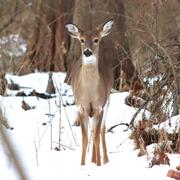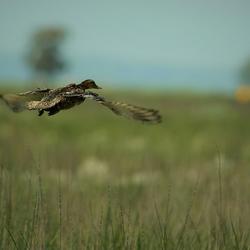Wildlife Disease Surveillance
Wildlife Disease Surveillance
Filter Total Items: 57
Mapping Chronic Wasting Disease Management: Identify Opportunities for Intervention
This research effort is an interagency partnership between U.S. Geological Survey and U.S. Fish and Wildlife Service to model the social-ecological system that encompasses chronic wasting disease management in the United States. Chronic wasting disease (CWD) is a fatal, neurologically degenerative disease that impacts many cervid species in North America (e.g., elk, moose, mule deer, and white...
North American Bat Monitoring Program (NABat)
Bats are essential contributing members of healthy, functioning ecosystems. They perform numerous ecosystem services like insect pest control and plant pollination, and provide enormous economic benefits through ecotourism, medical research, and novel biotechnologies. North American bats face unprecedented threats including habitat loss and fragmentation, white-nose syndrome, and wind energy...
Dynamics of Rabies Transmission in Vampire Bats (Desmodus rotundus) and Potential for Control Through Vaccination
Vampire bats ( Desmodus rotundus) are the primary spreader of rabies, a lethal disease that harms livestock and people across Latin America. Growth of the livestock industry and environmental changes in this region are leading to the expansion of vampire bats’ habitat range, and it is considered likely this species will move into the southern United States.
Understanding and Containing Chronic Wasting Disease
Chronic wasting disease (CWD) is a contagious and fatal neurodegenerative disease affecting cervids (deer, elk, caribou, and moose) that is threatening the health and sustainability of cervid populations across North America. CWD is caused by misfolded proteins known as prions, which can be transmitted by direct contact or environmental exposure.
Key Values of a Century of EESC Science
The USGS Eastern Ecological Science Center (EESC) is rooted in a proud tradition of service to the nation—advancing science that informs the conservation and management of fish, wildlife, and habitats across the eastern United States and beyond. Our mission is clear: deliver reliable, partner-driven science that supports natural resource decisions today, while ensuring these resources remain...
Avian Influenza Research
Since Public Law 109-148, USGS has partnered with state and federal agencies to conduct science to support the national response to highly pathogenic avian influenza (HPAI). In 2014, the first reports of HPAI in US wild birds came from USGS cause-of-death investigations confirmed by the USDA.
Avian Influenza Viral Pathogenicity
USGS is collaborating with numerous partner institutions to explore susceptibility and pathogenesis of relevant avian influenza strains in waterfowl species with special emphasis on sea ducks and diving ducks.
Avian Influenza Spread, Prevalence and Persistence
USGS researchers seek to understand the factors influencing the spread and persistence of avian influenza viruses on the landscape. This research also addresses how novel strains of highly pathogenic avian influenza are impacting a larger number and diversity of host species, including waterfowl, shorebirds, raptors and other birds.
Deriving Spatial and Temporal Waterfowl Inputs for Disease Risk Modeling
USGS is creating spatially and temporally explicit inputs to improve avian influenza transmission risk modeling. This project places special emphasis on wild bird distribution and abundance models as well as avian influenza prevalence models.
USGS Chronic Wasting Disease Research at NOROCK
Chronic wasting disease (CWD) is a growing management issue in the U.S. and has been detected in 36 states as of April 2025, including many western states. There is no cure or vaccine for CWD, and the disease threatens economically important animals like elk and deer. NOROCK scientists have taken a multi-pronged approach to develop actionable science including 1) evaluating CWD management options...
Genomics to Aid Conservation and restoration of the Yellow Lampmussel (Lampsilis cariosa) and Tidewater Mucket (Atlanticoncha ochracea)
Due to the rapid decline in abundance of Yellow Lampmussel ( Lampsilis cariosa) and Tidewater Mucket ( Atlanticoncha ochracea), USGS and partners at the U.S. Fish and Wildlife Service (USFWS) and Central Michigan University (CMU) are conducting an assessment of genetic diversity and population structure to inform appropriate recommendations for conservation and management of each species. These...
USGS Chronic Wasting Disease Research at the National Elk Refuge
Over the past 20 years, chronic wasting disease (CWD) in Wyoming has been spreading slowly outward from the southeastern corner of the state into the Greater Yellowstone Area and Wyoming's elk feed grounds. CWD detections have been getting closer to the National Elk Refuge, which provides supplemental feeding to approximately 8,000 elk and 500 bison each winter. NOROCK scientists have been...













